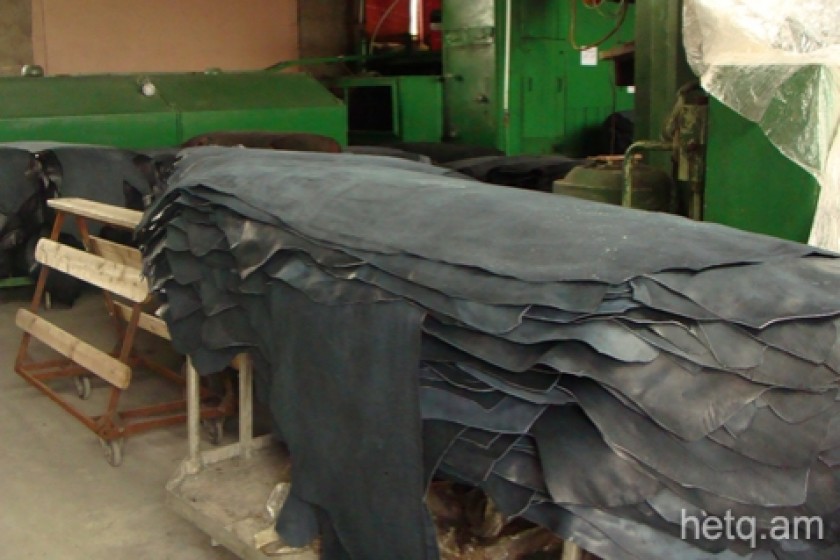
Armenian Leather Refinishers Cry Foul: Cite Unfair Competition from Iran, Turkey
The leather refinishing factory in Yerevan’s Erebouni neighbourhood is on the brink of closing despite having all the needed equipment and professional staff to produce top grade product.
The leather it manufactures isn’t being sold.
The plant, covering a huge site, merely operates two to three hours a day. Nevertheless, plant director Ashot Melkonyan calls in all the workers to show up, saying “I’ll find something to do for them.
In Armenia, employing ten to twelve people is no small feat.
The factory, registered under the name of Bizon Ltd, was founded in 2011.
“There was nothing here. I created all this myself,” says Melkonyan, listing the expenses of the operation.
 All the equipment was imported from Iran, Georgia and Russia, says Melkonyan, who also lived in the United States for a few years. That’s were his twin sons were born.
All the equipment was imported from Iran, Georgia and Russia, says Melkonyan, who also lived in the United States for a few years. That’s were his twin sons were born.
He explains that it would be difficult to close up shop, putting the workers out of a job.
Melkonyan adds that had he invested just a mere 10% of the cash he’s sunk in the factory, some $50,000) into another business, say the importation of leather from Iran for resale in Armenia, it would be much more profitable.
But he always wanted to start a manufacturing plant in Armenia so that “people would be connected to the land and not leave.”
The plant’s leather isn’t finding a market because, as Melkonyan argues, some people are importing leather from Iran and Turkey. He’s in competition with the importers.
 Melkonyan says that while the imported leather is more expensive than domestically produced leather, and while there is no difference in quality, Armenians prefer the foreign product as a matter of course.
Melkonyan says that while the imported leather is more expensive than domestically produced leather, and while there is no difference in quality, Armenians prefer the foreign product as a matter of course.
Even the plant’s leather sorted as “top grade” isn’t being sold, he says.
Thus, the plant faces closure in the face of Turkish and Iranian competition. But it’s not only the Armenian characteristic of preferring the “imported” product that’s the cause.
According to the National Statistical Service (NSS), imported leather from Iran and Turkey is listed as semi-finished product that needs to be finished in Armenian factories.
Ashot Melkonyan was surprised to learn that Armenia imports such semi-finished leather.
“Where does that leather go? It would either wind up here with me or else to Vardan (he means the Kashi Company-MM). That’s not the case,” he claimed.
Vardan Kirakosyan, the Kashi director, told me that they receive no semi-finished leather.
It should be noted that only the two companies listed above have the necessary equipment to refinish such leather.
Thus, the Turkish and Iranian imported leather is actually finished product, but is being graded as semi-finished at customs to qualify for a lower importation rate.
According to the NSS, Armenia imported 475 tons of semi-finished leather in 2013, 370 tons in 2012, 305 tons in 2011, and 250 tons in 2010.
The directors of the two above Armenian plants were at a loss to say where all this leather has been refinished.
Ashot Melkonyan noted that in Iran, as opposed to Armenia, leather refinishing gets government support in the form of free electricity. All the chemicals used in the process are produced in Iran, which further cuts back on costs.
Only a few of the materials in the refinishing process – salt, soda, lime – are produced in Armenia. The other 19 are imported from Iran and are appraised at so-called “market prices” at Armenian customs. Melkonyan, however, says it’s unclear how Armenian officials come up with these prices if they aren’t manufacture in Armenia.
Melkonyan is adamant that the quality of leather he produces is just as good as the Iranian imports. He says the quality of the Turkish imports might be better, but that’s because they possess a technology that can impart a “marketable” appearance to product derived from inferior raw material. Thus, it’s hard to say whether leather that looks good is actually better quality.

The day we arrived at the factory, the workers recounted how they started in the business as teenagers and how they operate the machinery.
Some used to work at the main leather factory in Yerevan (the current Kashi plant), at a time when Armenian leather was sold domestically and also exported.
They are the skilled workers who are now facing unemployment due to unfair competition from overseas and a lack of government oversight.
(To be continued)
 Videos
Videos Photos
Photos




Comments (2)
Write a comment